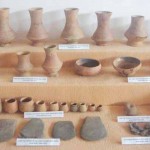Containing a great number of historical relics, the Museum of History and Culture in Hoi An is located at 7 Nguyen Hue Street. The museum was set up in 1989, and building used as museum today is the former Pagoda, ?Quan Yin?. The Museum of History and Culture in Hoi An was actually built as a religious establishment in the year 1635, and so it was set up accordingly.
The museum contains 273 exhibits and documents concerning the formation and development of Hoi An. The exhibits include pottery, ceramics, bronze, iron, paper, wood and so on, and are classified into three periods: Prehistory, Cham Pa Period and Dai Viet Period. These phases correspond to Sa Huynh Culture (before 2nd century AD), Cham Pa Culture (2nd-15th century AD) and Dai Viet, Dai Nam Culture (16th-19th century) respectively. In the development process, Dai Viet is prominently highlighted as a bright period in the historical path of Vietnam. This treasure house is home to a potpourri of relics such as important photographs and maps, artifacts such as statues of different materials belonging to different civilizations, porcelain and ceramic wares, traditional scales, anchor, jar-burials from the Sa Huynh culture and family records that trace back the ancestry of the inhabitants. Also among the exhibits are bronze drums dating back to 3000 BC, the era of the Dong Son civilization.
The documents displayed here constitute a numerous and diverse cultural treasure that testifies the formation and development of Hoi An through the great creativity of many generations of local residents. This museum is almost like a show-and-tell summary of the entire heritage of Hoi An. So visiting other museums will benefit you more if you have gone to the Museum of History and Culture in Hoi An first.
Visiting Hoi An Historical Museum is also a chance for tourists to explore more interesting aspects about this land. For instance, the history of Tran Phu Street, the oldest street of Hoi An, the meaning behind the ?eyes’ on the doors of the ancient houses and the spiral carved patterns “De leaf”, “Yin and Yang”, and many others.
Source: hoian-tourism.com
Post Views:
1,945







